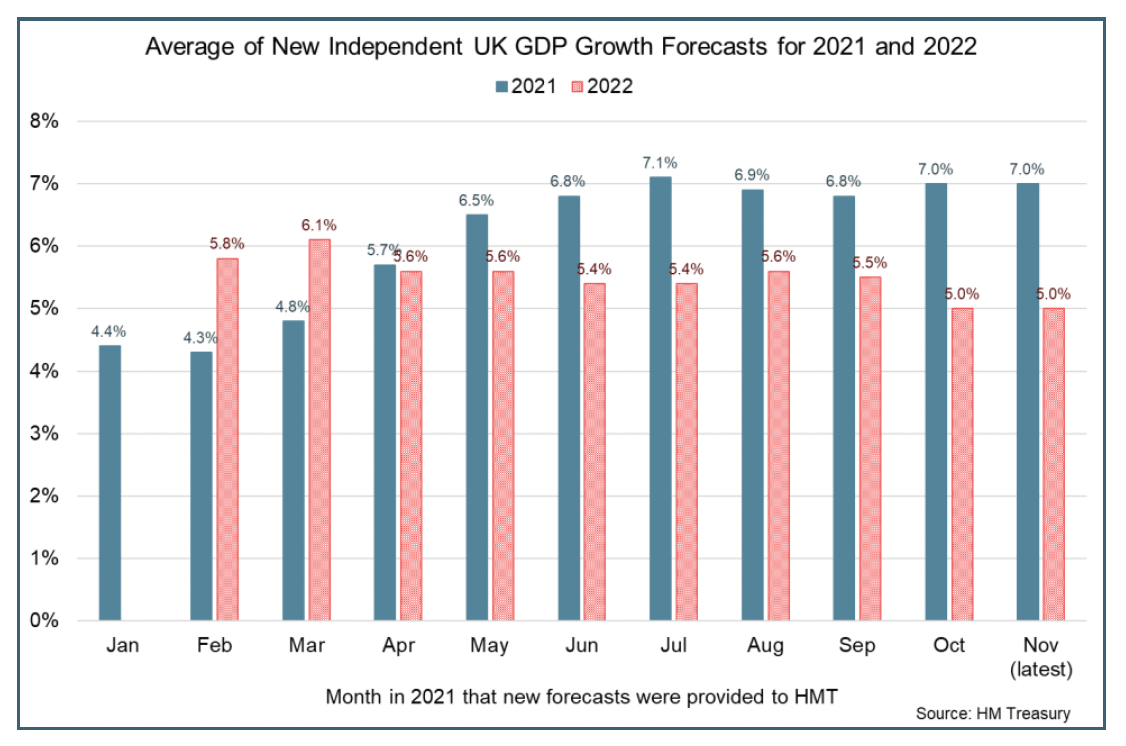State of the economy: November 2021
This report summarises recent developments in the global and Scottish economy and provides an analysis of the performance of, and outlook for, the Scottish economy.
This document is part of a collection
GDP Growth Outlook
Scotland's GDP is forecast to return to pre-pandemic levels in the first half of 2022, however supply chain disruption and inflationary pressures risk slowing the pace of recovery over the coming months.
Over the past year, the global economic outlook has strengthened following the introduction of vaccination programmes and the easing of restrictions on domestic and international activity.
In October, the IMF forecast global GDP to grow 5.9% in 2021, easing to 4.9% in 2022.[40] This is similar to latest OECD forecasts of 5.7% in 2021 and 4.5% in 2022.[41] However, the pace and stage of recovery varies significantly across countries. Furthermore, the emergence of bottlenecks in global supply chains and a sharp rise in inflationary pressures has softened the pace of recovery in recent months and provides downside risks and increasing uncertainty for the outlook.
These global factors are reflected in latest forecasts for Scotland and the UK. At a UK level, the Bank of England revised down their GDP growth forecasts in November to 7% in 2021 and 5% 2022 (down from 7.25% and 6% respectively in August) reflecting the headwinds which have emerged and the indicators of slower growth in the third quarter of the year.[42] This is in line with the average of new independent forecasts (published monthly by HMT) in November which forecast UK GDP growth of 7% in 2021 and 5% in 2022 and which have also moderated slightly in recent months.[43]

Scotland's GDP in August had recovered to 1.3% below its pre-pandemic level, having fallen over 20% below at the start of the pandemic, showing that there has been strong progress in the recovery to date. In the short term, latest data suggests the pace of growth during the third quarter of this year has slowed compared to earlier in the year when the economy was rebounding from the easing of restrictions and partly reflects the impacts of supply chain disruption weighing on growth. Furthermore, while businesses and households remain optimistic for further recovery over the coming year, the level of optimism has also eased in recent months.
In August, the Scottish Fiscal Commission (SFC) forecast Scotland's GDP to grow 6.7% in 2021 before moderating to 4% in 2022, with GDP returning to pre-pandemic levels in the second quarter of the year.[44] This is broadly in line with forecasts from the Fraser of Allander Institute in September which expect growth of 6.5% in 2021 and 4.8% in 2022, and for GDP to return to pre-pandemic levels in April 2022.[45]
Uncertainty in the labour market outlook has increased slightly in recent months as labour shortages in some sectors have emerged while the end of the furlough scheme presents a key step change in the support being provided to employment and incomes. In August, the SFC forecast unemployment could peak at 5.4% in Q4 2021 before gradually falling back to 4.4% at the start of 2023. When the furlough scheme ended at the end of September, there were around 80,000 jobs in Scotland under the scheme. It is too early to say how far this will lead to job losses, however initial survey data for October suggests many furloughed workers have returned to work.
Overall, current supply chain and inflationary pressures are largely expected to be temporary, however longer term the SFC forecast that trend GDP at the start of 2025 will remain 2% lower than in their pre-pandemic February 2020 forecast, illustrating the legacy effects that the economic shock to date is expected to have on the economy. The SFC will publish their next set of forecasts alongside the Scottish Budget on 9 December.
Contact
Email: OCEABusiness@gov.scot
There is a problem
Thanks for your feedback